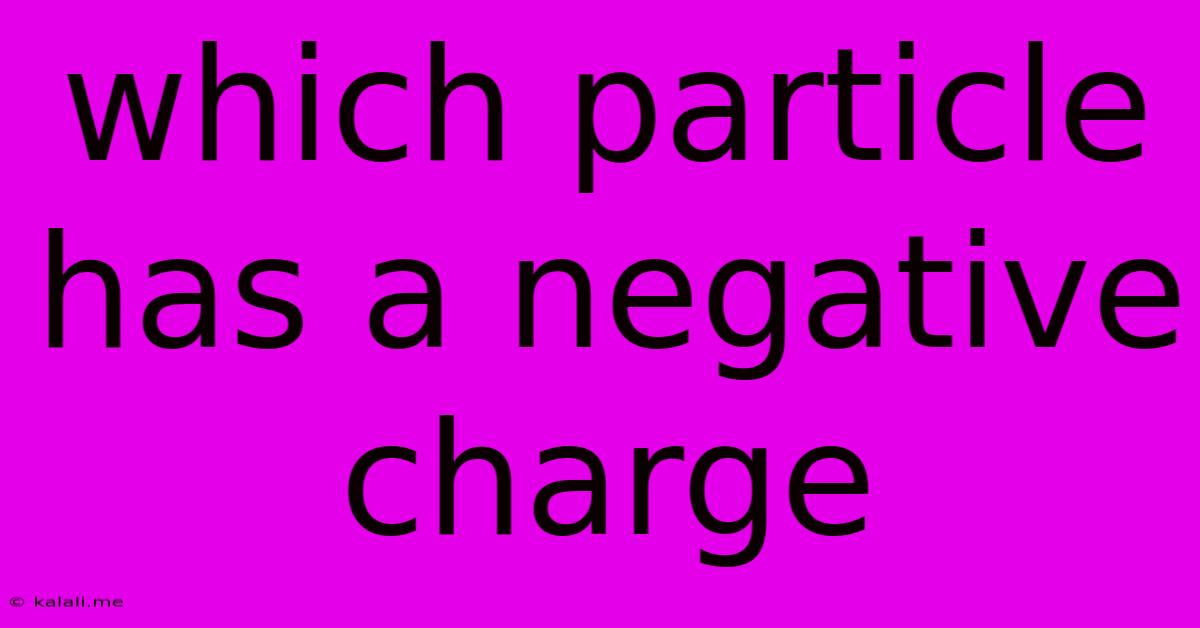Which Particle Has A Negative Charge
Kalali
May 10, 2025 · 2 min read

Table of Contents
Which Particle Has a Negative Charge? Understanding Subatomic Particles
This article explores the fundamental question: which particle has a negative charge? We'll delve into the world of subatomic particles, examining their properties and clarifying the role of negatively charged particles in the structure of matter. Understanding this fundamental concept is crucial for grasping basic physics and chemistry.
The answer, simply put, is the electron. Electrons are fundamental subatomic particles that carry a single unit of negative electric charge. They are found orbiting the nucleus of an atom, and their behavior dictates the atom's chemical properties and interactions with other atoms. This negative charge is balanced by the positive charge of protons in the nucleus, creating a neutral atom.
Exploring the Electron
Let's dive deeper into the characteristics of the electron:
- Charge: -1 (elementary charge)
- Mass: Approximately 1/1836 the mass of a proton, making it incredibly lightweight.
- Location: Orbitals surrounding the atom's nucleus. These orbitals aren't fixed paths, but rather regions of probability where the electron is most likely to be found.
- Spin: Electrons possess an intrinsic angular momentum called spin, which is quantized and contributes to their magnetic properties.
- Role in Chemistry: Electrons are the primary participants in chemical bonding. The transfer or sharing of electrons between atoms forms molecules and compounds.
Other Subatomic Particles and Their Charges
While the electron is the only fundamental particle with a negative charge, it's important to understand other subatomic particles and their charges for a complete picture:
- Proton: Located in the nucleus, protons carry a single unit of positive charge (+1). Their number determines the element's atomic number.
- Neutron: Also found in the nucleus, neutrons have no net electric charge (0). They contribute to an atom's mass but not its charge.
- Ions: Atoms that have gained or lost electrons become ions. Anions are negatively charged ions (gained electrons), while cations are positively charged ions (lost electrons). Understanding ions is critical for comprehending chemical reactions and solutions.
The Significance of Negative Charge
The negative charge of the electron plays a vital role in numerous physical phenomena:
- Electricity: The flow of electrons constitutes electric current. This fundamental principle underpins electrical circuits and countless technological applications.
- Magnetism: Moving electrons create magnetic fields, a phenomenon exploited in electric motors, generators, and other electromagnetic devices.
- Chemical Bonding: As mentioned, the interactions between electrons drive chemical reactions and the formation of molecules. This underlies the entire field of chemistry.
In conclusion, the electron is the subatomic particle that possesses a negative charge. Its properties and interactions are fundamental to our understanding of matter, energy, and the universe. This seemingly small particle plays a giant role in the world around us. Understanding its fundamental characteristics is key to grasping many scientific concepts.
Latest Posts
Latest Posts
-
How Many Grams Is Half An Oz
Jul 06, 2025
-
How Much Is 10 Quarters In Dollars
Jul 06, 2025
-
How Do You Beat Stage 9 On Bloxorz
Jul 06, 2025
-
What Is 1 2 Equivalent To In Fractions
Jul 06, 2025
-
How Do You Say Pork In Spanish
Jul 06, 2025
Related Post
Thank you for visiting our website which covers about Which Particle Has A Negative Charge . We hope the information provided has been useful to you. Feel free to contact us if you have any questions or need further assistance. See you next time and don't miss to bookmark.